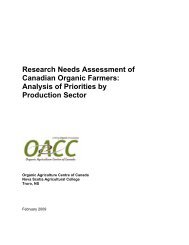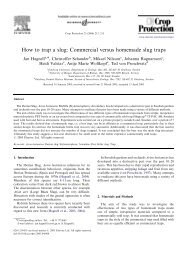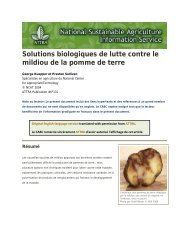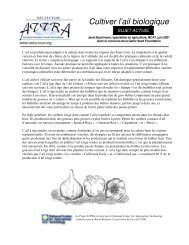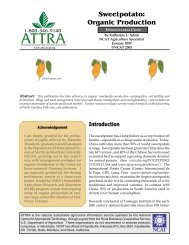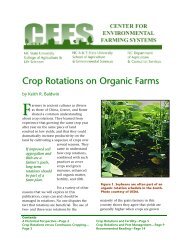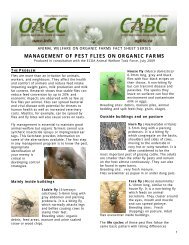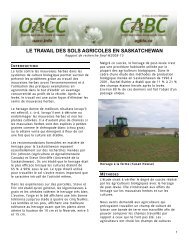You also want an ePaper? Increase the reach of your titles
YUMPU automatically turns print PDFs into web optimized ePapers that Google loves.
Disease ManagementThe impact of cover crops on pathogens—agents in the soil, such as bacteria orviruses, that cause disease—can be good,bad, or nonexistent. This impact variesbroadly depending on individual circumstancesand situations. A cover crop can actas a host <strong>for</strong> soilborne pathogens, or it canserve as an effective <strong>for</strong>m of biologicalcontrol <strong>for</strong> other plant pathogens.Incorporating cover crop residues can, insome cases, provide an organic food basethat encourages pathogen growth (Phillipset al., 1971). On the other hand, somecover crops, such as brassicas (cabbage andmustard), can actually decrease soilpathogen populations (Lewis and Papavizas,1971; Subbarao and Hubbard, 1996).The impact of a cover crop on a pathogeninvolves many variables. Principally, itdepends upon the pathogen’s nature andlife cycle requirements. For example, if thepathogen survives best on surface residueand the cover crop residue is left on the soilsurface as mulch, then the pathogen maysurvive until the next crop is planted andthe level of disease may increase (Fawcett,1987). Many plant diseases are associatedwith surface residue, <strong>for</strong> example, fungaland bacterial leaf blights (Boosalis andCook, 1973).At the same time, the increases in soilorganic matter provided by cover crops canenhance biological control of soilborneplant pathogens. This comes about boththrough direct antagonism and bycompetition <strong>for</strong> available energy, water,and nutrients (Sumner et al., 1986).Organisms that cause disease can also beaffected by changes in temperature,moisture, soil compaction, and bulkdensity, as well as nutrient dynamics.Whether or not the cover crop is in thesame family of plants (taxonomicallyrelated) to the subsequent cash crop canalso influence whether or not disease cyclesare interrupted or prolonged.Nematode ManagementNematodes are enough of a concern in thesandy soils of the southeastern U. S. to givethem individual attention when consideringdisease management. The root-knotnematode (Meloidogyne spp.) is particularlytroublesome in the Southeast. Agriculturalscientists have more questions thananswers concerning how to reduce populationsof nematodes with cover crops.They are struggling to find a selection ofcrop rotations with cover crops that canaddress a wide variety of nematodes thathave a very diverse host range (Reddy et al.,1986). They are also unclear, at this point,as to how some cover crops reduce thepopulation levels of certain nematodespecies.Examples of Nematode-Control Successwith Warm-Season LegumesWarm season legume cover crops are effectivein reducing populations of some plantparasiticnematodes:• Rhoades and Forbes (1986) reported thathairy indigo and joint vetch cover crops(coupled by mulching with clippings ofcowpea) were highly effective <strong>for</strong>maintaining low populations of B.longicaudatus and M. incognitanematodes.• Rodriguez-Kabana et al. (1992) reportedthat velvetbean was effective in loweringpopulation densities of several root-knotspecies (present simultaneously) ingreenhouse and field tests. Un<strong>for</strong>tunately,this is not always the case in field tests.<strong>Organic</strong> Production—<strong>Cover</strong> <strong>Crops</strong> <strong>for</strong> <strong>Organic</strong> <strong>Farms</strong> 5



